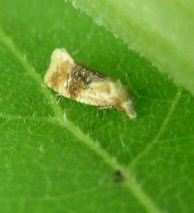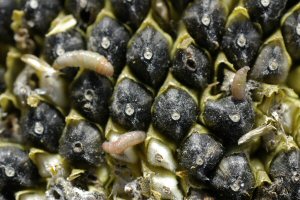Banded Sunflower Moth

Figure 1

Figure 2
Larvae feed on sunflower florets and seeds.
Host Crops
Commercial sunflowers. Several species of wild sunflowers are also known hosts of banded sunflower moth.
Biology
The banded sunflower moth (Cochylis hopses) is a small, straw-colored moth about 7mm (0.3 in) long (Figure 1). It has a brown triangular area in the middle portion of the front wings. Newly hatched larvae are off-white with a dark-brown head capsule and about 1.5 mm (0.06) long. As the larvae grow, there is a gradual color change to light pink or yellow, then to reddish or purplish and finally to green at maturity (Figure 2). Full-grown larvae are about 10mm (0.4 in) long.
The adult moths are present from about mid-July to mid-August. Moths fly from last year’s sunflower fields to the current year’s sunflower fields. Although some moths are in the sunflower field during the day, many rest in vegetation along field margins. At twilight, females move into the field to lay eggs. They lay eggs on the bracts of sunflower heads. Eggs hatch in 5 to 8 days. Larvae can be present in sunflower heads from about mid-July to mid-September. Mature larvae drop to the ground and spin cocoons in the soil where winter is passed. Pupation takes place in late June or early July the following year.
Newly hatched larvae move from the bracts to the florets of the sunflower head, where they enter open florets to feed. If eggs hatch prior to the opening of the florets, larvae will feed on bract tissue before moving to the florets. Larvae continue to feed in the florets until the third instar, reducing the total number of mature seeds produced. During later stages of development, the larvae tunnel through developing seeds, usually entering at the top and leaving after the contents are eaten. Each larva may destroy 6 to 7 mature seeds in addition to the florets eaten by the earlier instar larvae. Since the seed kernel is entirely consumed by the larva, the seed will normally pass through the combine.
The greatest damage by banded sunflower moth larvae has been shown to occur at the edge of the field.
Scouting Techniques
Fields should be monitored when plants are in the late bud (R-4) to early bloom stage (R-5.1) of development.
Monitor for adult moths in early evening or early morning when the moths are most active. Sampling sites should be at least 75 to 100 feet (23 to 30 m) from the field margin. Counting moths on 20 plants from 5 different sites for a total of 100 plants.
A sampling strategy based on scouting for adult moths during daylight hours has also been developed.
Economic Threshold
If monitoring in the early evening or early morning, one banded sunflower moth per two plants is a reasonable economic threshold.
If treatment is warranted , it should be applied at the R5.1 sunflower plant growth stage. Insecticides should be applied early in the morning or late in the day to minimize the adverse effect on bees and other pollinators.
Control Tips
Parasitic wasps attack both the eggs and larvae and general predators in the sunflower field also consume both larvae and eggs. Minute pirate bugs feed on the eggs and young larvae. Ground beetles can destroy about 40% of overwintering larvae and pupae. At least 4 different species of parasites attack the larvae of the banded sunflower moth.
